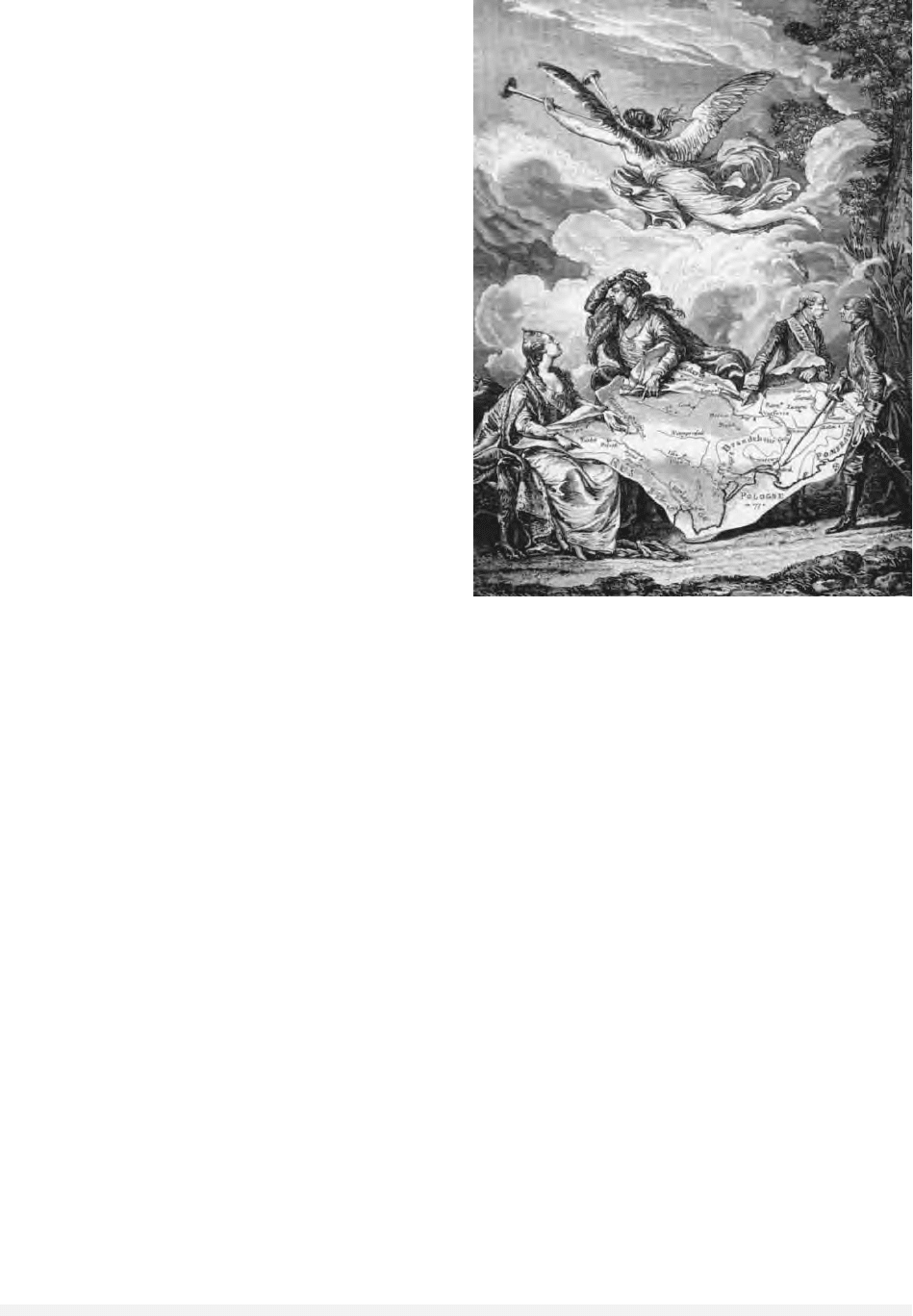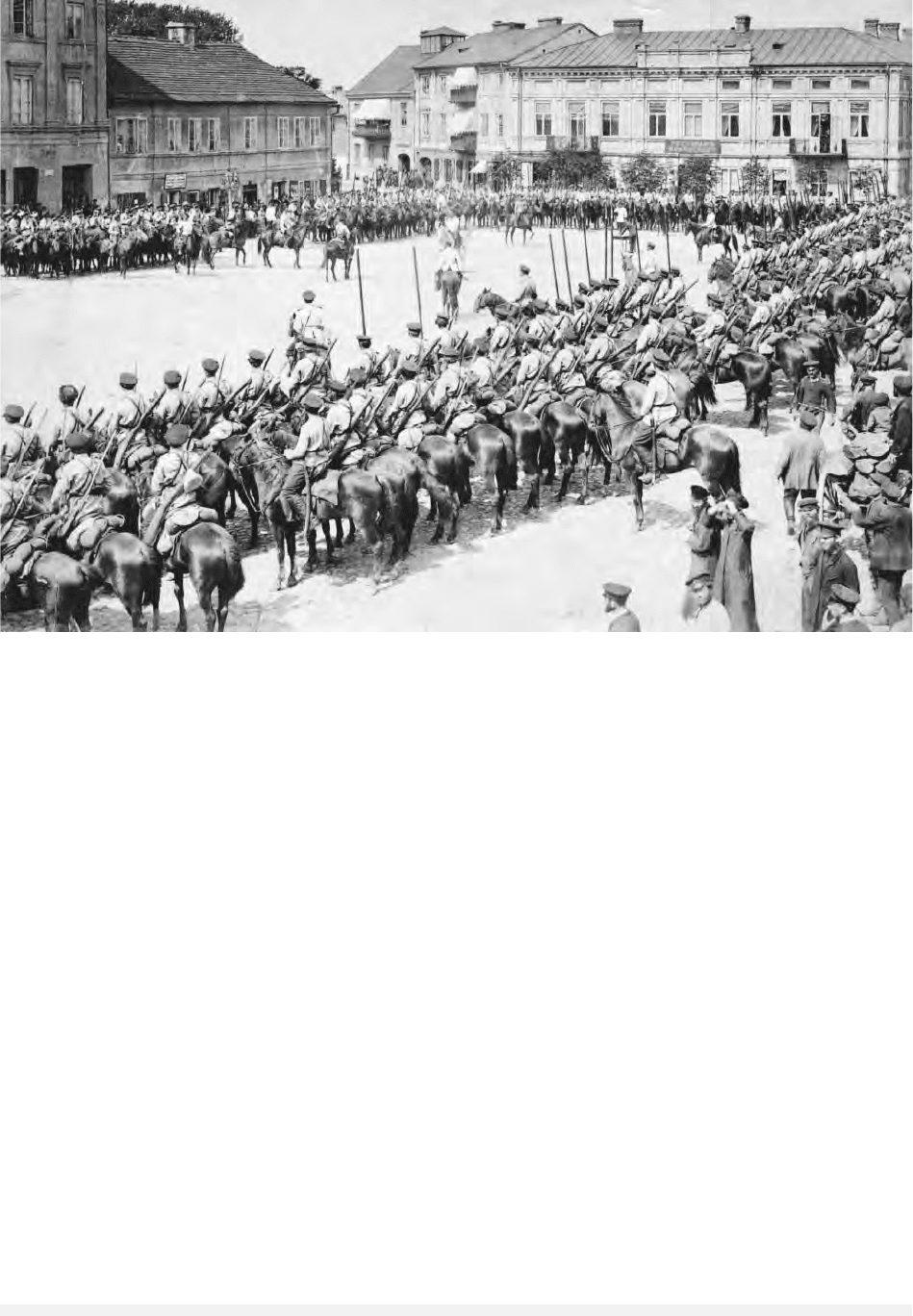Encyclopedia of Russian History
Подождите немного. Документ загружается.


“False Dmitry,” who claimed to be Ivan IV’s son
and triumphantly entered Moscow in 1605. In
great part because of the large Polish retinue and
openly Catholic sympathies of “Dmitry,” he was
soon deposed and murdered. But Polish interference
in confused Muscovite politics continued. Most
spectacularly, King Sigismund III of Poland suc-
ceeded in having his son Wladyslaw proclaimed
tsar in 1610. The Polish presence in Moscow was
not to last; by 1613 the Poles had been slaughtered
or forced to flee, and Mikhail Romanov was elected
tsar.
As Russia recovered and expanded under the
Romanovs, Poland grew weaker. Poland’s highly
decentralized government and elected king meant
that the central government could not impose its
will on the provinces. Increasingly, power devolved
to the local magnates, further weakening the cen-
ter. The anti-Polish rebellion of Bohdan Khmelnit-
sky in 1648 allowed Muscovy to extend its power
into the Ukraine with the Treaty of Pereiaslavl
(1654). Additional Polish territory, including the
cities of Smolensk and Kiev, was lost to the Rus-
sians during the following decade.
THE EIGHTEENTH CENTURY
The eighteenth century witnessed further Polish de-
scent into anarchy. Already during the 1690s Pol-
ish king Jan Sobieski had complained of his
inability to force the Polish magnates to obey him.
Worse was to come. The fact that Polish kings were
elected allowed Poland’s neighbors to put up their
own candidates in the hope of influencing future
policy. Poland also had the misfortune to be placed
geographically between three rising absolutist
states—Prussia, Russia, and Habsburg Austria. In
1764, St. Petersburg succeeded in placing its can-
didate on the Polish throne. Stanisl
-
aw-August
Poniatowski, a former lover of Catherine the Great,
was to be the last Polish king.
PARTITIONS AND RUSSIAN RULE
The impetus toward partition came not from Rus-
sia, but from Poland’s western neighbor, Prussia.
That state’s ambitious ruler, Frederick II (“the
Great”) suggested a dividing up of Polish territory
to prevent destabilizing “anarchy.” In the first Par-
tition of Poland (1772), Russia absorbed some thir-
teen percent of the commonwealth’s territory. The
shock of the partition fueled a push for serious po-
litical reforms, including a strengthening of the
central government and the king. The partitioning
powers, including Russia, feared a strong Poland.
They were particularly disturbed by the fruitful ef-
forts of the Four-Years-Sejm, including the Polish
constitution of May 3, 1791. Once again using the
excuse of Polish anarchy, Prussia and Russia seized
more Polish territory in the Second Partition of
1793, calling forth a Polish national uprising.
However, the heroic efforts of insurrectionist
Tadeusz Kosciuszko could not prevent the Third
Partition of 1795, after which Poland disappeared
from the European map for more than a century.
After the Napoleonic wars, borders between the
partitioning powers were altered significantly,
bringing a large portion of ethnic Poland under
Russian rule. The majority of Poles thus became
subjects of the Russian tsar. Tsar Alexander I af-
forded the Kingdom of Poland considerable rights
and autonomy. The Poles enjoyed their own
coinage, legal system, army, legislature, and con-
stitution. Disagreements between Warsaw and St.
Petersburg over the limits of Polish autonomy ex-
ploded into the open during the November Upris-
POLAND
1193
ENCYCLOPEDIA OF RUSSIAN HISTORY
A 1772 drawing shows Polish King Stanislav trying to hold onto
his crown while Poland is split between Catherine II and
Frederick II. © B
ETTMANN
/CORBIS

ing of 1830, which lasted well into the following
year. After Nicholas I put down this insurrection,
he abolished the Kingdom of Poland’s legislature,
constitution, and army. Still, legal and adminis-
trative differences existed between Russian and Pol-
ish provinces—though these differences would be
considerably narrowed after the crushing of the
subsequent January 1863 uprising.
The final half century of Romanov rule over
much of historic Poland has generally been char-
acterized as a period of Russification. Certainly, St.
Petersburg viewed Poles en masse as at least po-
tentially disloyal subjects, and Polish culture was
kept on a very tight leash. Poles in the Russian Em-
pire could not use their native tongue in education
at any level except the most elementary—and even
here Russian was often introduced. In the so-called
Western Provinces (present-day western Ukraine,
Lithuania, Belarus) even speaking Polish in public
could lead to fines or worse. Still, there was no sys-
tematic attempt to Russify the Polish nation in the
sense of total cultural (or religious) assimilation.
Rather, Russification amounted to a severe limiting
of Polish civil and cultural rights in this period.
WORLD WAR I AND INDEPENDENCE
The outbreak of World War I transformed relations
between the partitioning powers and Poles. Now
securing the loyalty of Poles became a paramount
consideration for both Russia and the Central Pow-
ers. The Russian commander-in-chief, Grand Duke
Nikolai Nikolayevich, issued a manifesto in mid-
August 1914, holding out the postwar promise of a
unified Polish state under the Romanov scepter. In
the end, force of arms decided the issue: By autumn
1915 Russian armies had for the most part been
pushed out of ethnic Poland. With the Bolsheviks’
coming to power in October 1917 and the subsequent
Treaty of Brest-Litovsk (March 1918), all hopes
of continued Russian—or Soviet—domination over
Poland came to an end. In late 1918 Poland regained
its independence.
Relations between Poland and the fledgling So-
viet state got off to a very bad start. Moscow was
POLAND
1194
ENCYCLOPEDIA OF RUSSIAN HISTORY
Russian troops in Warsaw after the January insurrection of 1863–1864. © H
ULTON
-D
EUTSCH
C
OLLECTION
/CORBIS

vitally interested in exporting revolution to West-
ern Europe, most likely by way of Poland. Further,
the unclear borders between Poland and its neigh-
bors to the east presented a serious potential for
conflict. Historically, Poles had been very promi-
nent as landowners and townspeople in these
border regions between ethnic Poland and ethnic
Russia. Thus Poles figure in early Soviet propa-
ganda as portly mustachioed noblemen bent on en-
slaving Ukrainian or Belarusian peasants. Between
1919 and 1921 Soviet Russia and newly indepen-
dent Poland clashed on the battlefield, the Poles oc-
cupying Kiev and, at the opposite extreme, the Red
Army getting all the way to the Vistula River in
central Poland. In March 1921, both sides, ex-
hausted for the moment, signed the Peace of Riga.
The USSR was not satisfied with the treaty’s
terms. In particular, hundreds of thousands of eth-
nic Belarusians and Ukrainians ended up on the Pol-
ish side of the frontier, providing the USSR with a
would-be constituency for extending the border
westward. Nor did relations between Poland and
the USSR improve in the interwar period. The two
primary politicians of interwar Poland, Józef
Pil
-
sudski and Roman Dmowski, both despised and
feared the Soviet state. The Communist Party was
outlawed in Poland, and many Polish communists
fled to the USSR, often straight into the Gulag. Even
Adolf Hitler’s coming to power in 1933 did not
bring the USSR and Poland closer. Rather, the later
1930s witnessed the Great Purges in the USSR and
a downward spiral in Polish politics toward an in-
creasingly vicious form of Polish chauvinism and
official anti-Semitism.
Poland was stunned by the Molotov-Ribben-
tropp Pact of August 1939. This agreement be-
tween Josef Stalin’s USSR and Hitler’s Germany
demonstrated that their mutual enmity toward the
Polish state outweighed ideological differences. The
pact allowed Hitler to invade on September 1, 1939,
and the Red Army, following a secret protocol, oc-
cupied eastern Poland later that month. Once again
Poland disappeared from the map. When the Pol-
ish state was resurrected in 1945, it was devastated.
The large and vibrant Polish Jewish community
had been all but wiped out during the Holocaust,
some three million non-Jewish Poles had lost their
lives, and the capital city Warsaw was a waste-
land, systematically destroyed by the Germans in
retaliation for the Warsaw Uprising of August
1944. Polish nationalists and some Western writ-
ers contend that the Red Army, by that time near-
ing the eastern outskirts of the city, could have
prevented the Nazi devastation of the city. Others
argue that the Red Army had been successfully re-
pulsed by the Germans. In any case, the failure of
the Soviets to move into Warsaw allowed the Nazis
to massacre Polish fighters who might very well
have opposed the imposition of communist rule.
PEOPLE’S POLAND
Having liberated Poland from the Nazis, Stalin was
determined to see a pro-Soviet government installed
there. Despite the tiny number of native Polish
communists and little support for communist or
pro-Soviet candidates, intimidation and rigged vot-
ing placed a Stalinist Polish government, led by
Bolesl
-
aw Bierut, in power in 1948. Bierut launched
a crash industrialization drive, attempted to collec-
tivize Polish agriculture, and jailed many Catholic
clergymen. After Bierut’s death in 1956, leadership
passed to the more flexible Wladyslaw Gomulka
who allowed Poles a considerable amount of cul-
tural and economic leeway while reassuring Moscow
of People’s Poland’s stability.
Unfortunately for Gomulka, Poles compared
their economic and cultural situation not with that
in the USSR, but with conditions in the West. As
the 1960s progressed, the relative backwardness of
Poland compared with Germany or the United
States only increased. Domestically, internal party
tensions led to an ugly state-sponsored anti-Semitic
episode in 1968, during which Poland’s few re-
maining Jews—most highly assimilated—were
hounded out of the country. Thus, Gomulka’s po-
sition was already weak before the notorious price
hikes on basic foodstuffs of December 1970 that
led to rioting and his replacement by Edward
Gierek. Gierek promised prosperity, but was never
able to deliver. In 1980, price increases caused civil
disturbances and his resignation.
The discontent of 1980 also spawned some-
thing quite new: the Polish trade union Solidarity.
This first independent trade union in a communist
bloc country appeared in late 1980, was banned
just more than one year later, and was resurrected—
more properly, relegalized—during the late 1980s.
Solidarity represented a novel phenomenon for
a People’s Democracy: a popular and independent
trade union that brought together intellectuals and
workers. The outlawing of Solidarity by General
Wojciech Jaruzelski in December 1981 was a des-
perate measure taken, according to Jaruzelski him-
self, to forestall an actual Soviet invasion of the
country. One may doubt Jaruzelski’s account, but
POLAND
1195
ENCYCLOPEDIA OF RUSSIAN HISTORY

tensions between the USSR and Poland certainly ran
high, and the threat of invasion cannot be entirely
discounted. Ultimately, however, Jaruzelski’s at-
tempt to save People’s Poland failed. Early in 1989
Solidarity was relegalized and in summer of that
year the communists handed over power to Tadeusz
Mazowiecki, the first noncommunist prime minis-
ter since the 1940s. The refusal of Soviet leader
Mikhail Gorbachev to intervene in Polish affairs
made possible this peaceful transfer of power.
Relations between Poland and Russia during the
1990s have been remarkably positive, considering
the amazing changes brought by that decade. De-
spite grumbling and even saber rattling from
Moscow over Poland’s plans to join the North At-
lantic Treaty Organization (NATO), in the end
NATO expansion took place in 1999 without a
hitch. At the same time, economic and cultural
links between Moscow and Warsaw have weak-
ened considerably as Poland has turned toward the
West both institutionally (NATO, European Union)
and culturally (learning English instead of Russ-
ian). Still, the correct if not always cordial relations
between the two countries during the 1990s give
reason for hope that the two largest Slavic nations
will finally be able to both live together and pros-
per.
See also: CATHOLICISM; LITHUANIA AND LITHUANIANS;
NATIONALISM IN THE SOVIET UNION; NATIONALISM
IN TSARIST EMPIRE; ORGANIC STATUTE OF 1832; POLES;
POLISH REBELLION OF 1863; POLISH-SOVIET WAR; SAR-
MATIANS; TIME OF TROUBLES
BIBLIOGRAPHY
Davies, Norman. Heart of Europe: A Short History of
Poland. (1984). Oxford, UK: Oxford University
Press.
Gross, Jan. (1988). Revolution from Abroad: The Soviet Con-
quest of Poland’s Western Ukraine and Western Be-
lorussia. Princeton, NJ: Princeton University Press.
Jedlicki, Jerzy. (1999). A Suburb of Europe: Nineteenth-
Century Polish Approaches to Western Civilization. Bu-
dapest: Central European University Press.
Polonsky, Antony. (1972). Politics in Independent Poland
1921–1939: The Crisis of Constitutional Government.
Oxford, UK: Clarendon Press.
Snyder, Timothy. (2003). The Reconstruction of Nations:
Poland, Ukraine, Lithuania, Belarus, 1569–1999. New
Haven, CT: Yale University Press.
Walicki, Andrzej. (1991). Russia, Poland, and Universal
Regeneration: Studies on Russian and Polish Thought of
the Romantic Epoch. Notre Dame, IN: University of
Notre Dame Press.
Wandycz, Piotr. (1974). The Lands of Partitioned Poland,
1795–1918. Seattle: University of Washington Press.
T
HEODORE
R. W
EEKS
POLAR EXPLORERS
From its earliest days, Russia was concerned with
Arctic settlement and development. Actual explo-
ration began during the eighteenth century and
continued, although Russia took little part in the
classic race for the North and South poles. Interest
heightened after 1920, as the USSR transformed it-
self into a key player in North polar exploration.
After 1956, the USSR became an important force
in Antarctic research.
Russian migration to the Arctic coast began
during the eleventh century. Further settlement
was tied to the foundation of religious communi-
ties (such as the Solovetsky Monastery, built in
1435); demand for furs and precious metals; the
search for the Northeast Passage (in Russian, the
Northern Sea Route); the establishment of ports
such as Arkhangelsk (1584); and Russia’s eastward
expansion into Siberia during the sixteenth and sev-
enteenth centuries.
Scientific and exploratory work got underway
during the 1700s and 1800s. On behalf of the Russ-
ian government, Danish captain Vitus Bering, with
Alexei Chirikov as his second-in-command, launched
his Kamchatka (1728–1730) and Great Northern
(1733–1749) expeditions. Afterward, the Admi-
ralty and Academy of Sciences sponsored many
voyages and expeditions, surveying or exploring
Spitsbergen, Novaya Zemlya, the New Siberian Is-
lands, Wrangel Island, and Franz Josef Land. The
colonization of Alaska and incorporation of the
Russian-American Company (1799) necessitated
greater familiarity with the Arctic. Key figures
from this period include Fyodor Rozmyslov (d.
1771), Vasily Chichagov (1726–1809), Matvei
Gedenshtrom (1780–1843), Academy of Sciences
president Fyodor Litke (1797–1882), and Alexan-
der Sibiryakov (1844–1893). The latter sponsored
the first successful crossing of the Northeast Pas-
sage: Adolf Erik Nordenskjold’s 1878–1879 voyage
in the Vega.
During the late 1800s and early 1900s, as in-
ternational audiences thrilled to the daring exploits
POLAR EXPLORERS
1196
ENCYCLOPEDIA OF RUSSIAN HISTORY

of explorers like Peary and Scott, Russian polar
work focused on scientific, commercial, and mili-
tary concerns. Admiral Stepan Makarov formed a
Russian icebreaker fleet, while naval officer Alexan-
der Kolchak, later famous as a White commander
during the Russian civil war, explored the Arctic.
Early twentieth-century expeditions under Ernst
Toll, Vladimir Rusanov, Georgy Brusilov, and
Georgy Sedov ended in tragedy. By contrast, in
1914, Yan Nagursky became the first pilot suc-
cessfully to fly an airplane above the Arctic Circle.
In 1914–1915, Boris Vilkitsky completed the sec-
ond traversal of the Northeast Passage.
Under the Soviet regime, polar exploration and
development fell to agencies such as the All-Union
Arctic Institute (VAI) and, after 1932, the Main Ad-
ministration of the Northern Sea Route (GUSMP).
Prominent Arctic scientists included Vladimir Vize,
Georgy Ushakov, and Rudolf Samoilovich of the
VAI, as well as Otto Shmidt, head of GUSMP. The
USSR made impressive headway during the 1920s
and 1930s in building an economic and trans-
portational infrastructure in the polar regions. This
was also an era of spectacular public triumphs, in-
cluding the rescue of Umberto Nobile and the crew
of the dirigible Italia (1928); participation in the
Arctic flight of the airship Graf Zeppelin (1931); the
Sibiryakov’s first single-season crossing of the North-
east Passage (1932); the airlift of the Chelyuskin’s
crew and passengers, who survived two months
on the Arctic ice after their ship sank (1933–1934);
the flights of Valery Chkalov and Mikhail Gromov
over the North Pole on their way to the United
States (1937); the first airplane landing at the
North Pole (1937); and the establishment of the
first research outpost at the North Pole, the SP-1,
under the leadership of Ivan Papanin (1937–1938).
In 1941 the Soviets also accomplished the first air-
plane landing at the Pole of Relative Inaccessibility.
There was, of course, an ugly underside to Soviet
achievement in the Arctic: Not only was much So-
viet polar work characterized by inefficiency and
periodic mishaps, both major and minor, but it was
closely linked to the steady expansion of forced la-
bor in the GULAG system.
Soviet polar exploration resumed after World
War II. A new generation of researchers, including
A.A. Afanasyev, Vasily Burkhanov, Mikhail So-
mov, Alexei Treshnikov, Boris Koshechkin, and
others, came to the forefront. A second North Pole
outpost (SP-2) was established in 1950, and until
the late 1980s, the USSR operated at least two SP
stations at any given time. In 1977, the atomic ice-
breaker Arktika became the first surface vessel to
reach the North Pole.
As for the Antarctic, Russian mariners Fabian
Bellingshausen (1770–1852) became, in 1820, one
of the first three explorers knowingly to sight the
Antarctic continent (the first person to sight
Antarctica remains a matter of debate). The USSR
did not engage in serious exploration of the Antarc-
tic until 1956. During the International Geophys-
ical Year of 1957–1958, the USSR was one of
twelve nations to establish stations in Antarctica.
In 1959, the USSR signed the Antarctic Treaty,
which went into effect in 1961. As with the Arc-
tic, the collapse of the USSR in 1991 made it diffi-
cult for the Russians to continue Antarctic research,
although Russia still maintains stations there year-
round.
See also: BERING, VITUS JONASSEN; CHIRIKOV, ALEXEI
ILICH
BIBLIOGRAPHY
Armstrong, Terence. (1958). The Russians in the Arctic.
London: Methuen.
Armstrong, Terence. (1965). Russian Settlement in the
North. Cambridge, UK: Cambridge University Press.
McCannon, John. (1998). Red Arctic: Polar Exploration
and the Myth of the North in the Soviet Union,
1932–1939. New York: Oxford University Press.
Taracouzio, T. A. (1938). Soviets in the Arctic. New York:
Macmillan.
J
OHN
M
C
C
ANNON
POLES
The Poles represent the northwestern branch of the
Slavonic race. They speak Polish, a member of the
Western Slavic branch of the Indo-European lan-
guage family. It is most closely related to Be-
lorussian, Czech, Slovak, and Ukrainian. From the
very earliest times the Poles have resided on the ter-
ritory between the Carpathians, Oder River, and
North Sea. Bolesl
-
aw I “Chrobny” or the Brave
(967–1025) united all the Slavonic tribes in this re-
gion into a Polish kingdom, which reached its
zenith at the close of the Middle Ages and slowly
declined during the mid to late eighteenth century.
Hostility to Polish nationalism formed a common
bond between the Russian, Prussian, and Austrian
governments. Thus, Poland was partitioned four
POLES
1197
ENCYCLOPEDIA OF RUSSIAN HISTORY

times. The first partition (August 1772) divided
one-third of Poland between the three above-named
countries. The second partition (January 1793)
was mostly to the advantage of Russia; Austria did
not acquire land. In the third partition (October
1795), the rest of Poland was divided up between
the three autocracies. After the defeat of Napoleon
and collapse of his puppet state, the Grand Duchy
of Warsaw (1807–1814), a fourth partition oc-
curred (1815), by which the Russians pushed west-
ward and incorporated Warsaw. Until then
Warsaw had been situated in Prussian Poland from
1795 to 1807. Potent anti-Russian sentiment has
long prevailed among the Poles who are predomi-
nantly Catholic, especially during the eighteenth
and nineteenth centuries, as evidenced by four pop-
ular uprisings against the Slavic colossus to the
east: 1768, 1794, 1830–1831, and 1863. Accord-
ing to the 1890 census about 8,400,000 Poles
resided in the Russian Empire.
Finally in 1918, an independent Poland was re-
constituted. Later in August 1939 a pact was signed
between Adolf Hitler’s Germany and Josef Stalin’s
Soviet Union, which contained a secret protocol au-
thorizing yet a fifth partition of Poland: “In the
event of a territorial and political rearrangement of
the areas belonging to the Polish state the spheres
of influence of Germany and the USSR shall be
bounded approximately by the line of the rivers
Narew, Vistula, and San.” The next month Hitler’s
Germany invaded Poland; the Red Army did not in-
terfere.
After more than four decades of the Cold War,
during which Poland was a Soviet “satellite” and be-
longed to the Soviet-led Warsaw Pact, partially free
elections were held in 1989. The Solidarity move-
ment won sweeping victories; Lech Wal
-
esa became
Poland’s first popularly elected post-Communist
president in December 1990. In 1999 Poland joined
the North Atlantic Treaty Organization, along with
Hungary and the Czech Republic. It is scheduled to
enter the European Union in 2004.
See also: NATIONALITIES POLICIES, SOVIET; NATIONALITIES
POLICIES, TSARIST; POLAND
BIBLIOGRAPHY
Connor, Walter D., and Ploszajski, Piotr. (1992). The Pol-
ish Road from Socialism: The Economics, Sociology, and
Politics of Transition. Armonk, NY: M. E. Sharpe.
Hunter, Richard J., and Ryan, Leo. (1998). From Autarchy
to Market: Polish Economics and Politics, 1945–1995.
Westport, CT: Praeger.
Lukowski, Jerzy, and Zawadzki, Hubert. (2002). A Con-
cise History of Poland. New York: Cambridge Uni-
versity Press.
Michta, Andrew A. (1990). Red Eagle: The Army in Polish
Politics, 1944–1988. Stanford, CA: Hoover Institu-
tion Press.
Snyder, Timothy. (2003). The Reconstruction of Nations:
Poland, Ukraine, Lithuania, Belarus, 1569–1999. New
Haven, CT: Yale University Press.
J
OHANNA
G
RANVILLE
POLICE See STATE SECURITY, ORGANS OF.
POLISH REBELLION OF 1863
After decades of harsh limits on Polish autonomy,
many Poles were hopeful that the situation would
improve after the 1855 coronation of Alexander II.
There were indeed concessions: Martial law was
lifted, an amnesty was declared for all political pris-
oners, a new Archbishop of Warsaw was named
(the position had been vacant since 1830), and cen-
sorship was made somewhat less restrictive. In
1862 a Pole named Aleksander Wielopolski was
made governor of the Polish Kingdom, in an at-
tempt to cooperate with the aristocratic elite and
marginalize more radical national separatists and
democratic revolutionaries. All these attempts at
conciliation failed, as patriotic demonstrations broke
out in late 1861 and intensified throughout 1862.
The Russians tried to suppress these protests with
deadly force, but that only generated more anger
among the Poles, and the unrest spread.
Wielopolski tried to quash the disturbances on
the night of January 23 by organizing an emer-
gency draft into the army targeted at the young
men who had been leading the demonstrations.
This, too, failed, as it prompted the national move-
ment leaders to proclaim an uprising (which was
being planned in any case). The rebels proclaimed
the existence of the “Temporary National Govern-
ment,” which would lead the revolt and (they
hoped) pave the way for a true independent Polish
government afterwards.
The “January Uprising” (as it is known in
Poland) was fought primarily as a guerrilla war,
with small-scale assaults against individual Russ-
ian units rather than large pitched battles (which
the Poles lacked the forces to win). Over the next
one and one-half years, 200,000 Poles took part in
POLICE
1198
ENCYCLOPEDIA OF RUSSIAN HISTORY

the fighting, with about 30,000 in the field at any
one moment.
After the revolt was crushed, thousands of
Poles were sent to Siberia, hundreds were executed,
and towns and villages throughout Poland were
devastated by the violence. All traces of Polish au-
tonomy were lost, and the most oppressive period
of Russification began.
See also: POLAND
BIBLIOGRAPHY
Leslie, R. F. (1963). Reform and Insurrection in Russian
Poland, 1856–1865. London: University of London,
Athlone Press.
Wandycz, Piotr. (1974). The Lands of Partitioned Poland,
1795–1918. Seattle: University of Washington Press.
B
RIAN
P
ORTER
POLITBURO
The Politburo, or Political Bureau, was the most
important decision-making and leadership organ in
the Communist Party, and has commonly been
seen as equivalent to the cabinet in Western polit-
ical systems. For most of the life of the Soviet sys-
tem, the Politburo (called the Presidium between
1952 and 1966) was the major focus of elite po-
litical life and the arena within which all impor-
tant issues of policy were decided. It was the heart
of the political system.
The Politburo was formally established at the
Eighth Congress of the Party in March 1919 and
held its first session on April 16. Formed by the
Central Committee (CC), the Politburo was to make
decisions that could not await the next meeting of
the CC, but over time its smaller size and more fre-
quent meeting schedule meant that effective power
drained into it and away from the CC. There had
been smaller groupings of leaders before, but these
had never become formalized nor had they taken
an institutional form. The establishment of the
Politburo was part of the regularization of the lead-
ing levels of the Party that saw the simultaneous
creation of the Orgburo and Secretariat, with these
latter two bodies meant to ensure the implementa-
tion of the decisions of leading Party organs, in
practice mostly the Politburo.
From its formation until late 1930, the Polit-
buro was one arena within which the conflict be-
tween Josef Stalin and his supporters on the one
side and successive groups of oppositionists among
the Party leadership was fought out, but with the
removal of Mikhail Tomsky in 1930, the last open
oppositionist disappeared from the Politburo.
Henceforth the body remained largely controlled by
Stalin. Its lack of institutional integrity and power
is illustrated by the fact that various of its mem-
bers were arrested and executed during the terror
of the mid- to late 1930s. After World War II, the
Politburo ceased even to meet regularly, being ef-
fectively replaced by ad hoc groupings of leaders
that Stalin mobilized on particular issues and when
it suited him.
Following Stalin’s death in 1953, the leading
Party organs resumed a more regular existence, al-
though Nikita Khrushchev’s style was not one well
suited to the demands of collective leadership; he
often sought to bypass the Presidium. Under Leonid
Brezhnev, the Politburo became more regularized,
and the overwhelming majority of national issues
seem to have been discussed in that body, although
an important exception was the decision to send
troops into Afghanistan in 1979. For much of the
Mikhail Gorbachev period, too, the Politburo was
at the heart of Soviet national decision making, al-
though the shift of the Soviet system to a presi-
dential one and the restructuring of the Politburo
at the Twenty-Eighth Congress in 1990 effectively
sidelined this body as an important institution.
The Politburo was always a small body. The
first Politburo consisted of five full and three can-
didate (or nonvoting) members; at its largest, when
it was elected at the Nineteenth Congress in 1952
and was probably artificially large because Stalin
was planning a further purge of the leadership (it
was also envisaged that there would be a small, in-
ner body), it comprised twenty-five full and eleven
candidate members. Generally in the post-Stalin pe-
riod it had between ten and fifteen full and five to
nine candidates. Membership has tended to include
a number of CC secretaries, leading representatives
from state institutions (although the foreign and
defense ministers did not become automatic mem-
bers until 1973) and sometimes one or two re-
publican party leaders. Gorbachev changed this
pattern completely in 1990 by making all republi-
can party leaders members of the Politburo along
with the general secretary and his deputy, and
eliminating candidate membership. It was over-
whelmingly a male institution, with only two
women (Ekaterina Furtseva and Alexandra Bir-
iukova) gaining membership, and it was always
dominated by ethnic Slavs, especially Russians.
POLITBURO
1199
ENCYCLOPEDIA OF RUSSIAN HISTORY

While the frequency of Politburo meetings is
somewhat uncertain for much of its life, it seems
to have met on average about once per week in the
Brezhnev period and after, with provision for a fur-
ther meeting if required. Meetings were attended
by all members plus a range of other people who
might be called in to address specific items on the
agenda. In addition, some issues were handled by
circulation among the members, thereby not re-
quiring explicit discussion at a meeting. No public
differences of opinion between Politburo members
were aired before the breakdown of many of the
rules of Party life under Gorbachev, and public una-
nimity prevailed. It is not clear that votes were ac-
tually taken; issues seem to have been resolved
through discussion and consensus. Whatever the
process, the Politburo was the central leadership site
of the Party and the Soviet system as a whole.
See also: BREZHNEV, LEONID ILICH; CENTRAL COMMITTEE;
COMMUNIST PARTY OF THE SOVIET UNION; GOR-
BACHEV, MIKHAIL SERGEYEVICH; PRESIDIUM OF
SUPREME SOVIET; STALIN, JOSEF VISSARIONOVICH
BIBLIOGRAPHY
Laird, Roy D. (1986). The Politburo: Demographic Trends,
Gorbachev and the Future. Boulder, CO: Westview
Press.
Lowenhardt, John; Ozinga, James R.; and van Ree, Erik.
(1992). The Rise and Fall of the Soviet Politburo. Lon-
don: UCL Press.
G
RAEME
G
ILL
POLITICAL PARTY SYSTEM
Following years of one-party politics in the Soviet
Union, post-communist Russia experienced a burst
of party development during the 1990s. Still, Rus-
sia’s party system remains underdeveloped. Al-
though political parties run candidates in national
parliamentary elections, Russia’s first two presi-
dents, Boris Yeltsin and Vladimir Putin, chose not
to affiliate themselves with political parties. Rus-
sia’s constitution gives the president the power to
form the government without reference to the bal-
ance of party strength in the parliament. Politicians
in the State Duma usually affiliate themselves with
parties or party-like factions, but almost no par-
ties have well-developed organizational bases among
the electorate. Most voters have only dim concep-
tions of the policy positions of the major political
parties. New parties constantly form and dissolve.
The function often ascribed to political parties
in developed democracies—that of linking voters’
interests with the policy decisions of government—
is scarcely visible in Russia. Nonetheless, a rudi-
mentary party system was in place by the late
1990s.
Russia’s parties may be characterized as fall-
ing into five major types. On the left are Marxist-
Leninist parties. The most prominent example is the
Communist Party of the Russian Federation, headed
by Gennady Zyuganov. The CPRF is characterized
by a militantly anti-capitalist stance, which it com-
bines with appeals to Russian statist, nationalist,
and religious traditions. It is the strongest political
party in Russia both in its membership and in the
number of votes it attracts in elections (it can count
on the support of about 20 to 25 percent of the
electorate). It also enjoys a distinct ideological iden-
tity in voters’ minds. Despite its large following,
however, it has been unable to exercise much in-
fluence in policy making at the national level. Other
parties on the left are still more radical in their ide-
ologies and call for a return to Soviet-era political
and economic institutions; some expressly advocate
a return to Stalinism.
A second group of parties can be called “social
democratic.” They accept the principle of private
ownership of property. At the same time, they call
for a more interventionist social policy by the gov-
ernment to protect social groups made vulnerable
by the transition from communism. The party
headed by Grigory Yavlinsky, called Yabloko, is an
example. Yabloko attracts 7 to 10 percent of the
vote in national elections. Other parties that iden-
tify themselves as social democratic—including
a party organized by former president Mikhail
Gorbachev—have fared poorly in elections.
A third group of parties strongly advocate
market-oriented policies. They press for further
privatization of state assets, including land and in-
dustrial enterprises. They also seek closer integra-
tion of Russia with the West and the spread of
values such as respect for individual civil, political,
and economic liberties. The most prominent exam-
ple of such a party is the Union of Rightist Forces,
which drew around 8 percent of the vote in the
2000 parliamentary election.
A fourth group of parties appeal to voters on
nationalist grounds. Some call for giving ethnic
Russians priority treatment in Russia over ethnic
minorities. Others demand the restoration of a
POLITICAL PARTY SYSTEM
1200
ENCYCLOPEDIA OF RUSSIAN HISTORY

Russian empire. They denounce Western influences
such as individualism, materialism, and competi-
tiveness. Some believe that Russia’s destiny lies
with a Eurasian identity that straddles East and
West; others take a more straightforwardly statist
bent and call for restoring Russian military might
and centralized state power. Nationalist groups are
numerous and skillful at attracting attention, but
tend to be small. However, Vladimir Zhirinovsky’s
Liberal Democratic Party of Russia gained some
successes in elections during the 1990s (22% in
1993, 12% in 1995).
The fifth group may be called “parties of
power.” These are parties that actively avoid tak-
ing explicit programmatic stances. They depend in-
stead on their access to state power and the
provision of patronage benefits to elite supporters.
Their public stance tends to be centrist, pragmatic,
and reassuring. The major party of power in the
2000 election was “Unity,” which benefited from
an arms-length association with Vladimir Putin.
The problem for parties of power is that they have
little to offer voters except their proximity to the
Kremlin; if their patrons reject them or lose power,
they quickly fade from view.
Many voters can identify a party that they pre-
fer over others, but Russian voters on the whole
mistrust parties and feel little sense of attachment
to them. Likewise most politicians, apart from
Communists, feel little loyalty or obligation to par-
ties. The conditions favoring the development of
a party system—a network of civic and social as-
sociations able to mobilize support behind one or
another party, and a political system in which
the government is based on a party majority in
parliament—remain weak in Russia. It is likely that
the development of a strong, competitive party sys-
tem will be a protracted process.
See also: COMMUNIST PARTY OF THE RUSSIAN FEDERA-
TION; LIBERAL DEMOCRATIC PARTY; UNION OF RIGHT
FORCES; YABLOKO.
BIBLIOGRAPHY
Colton, Timothy J. (2000). Transitional Citizens: Voters
and What Influences Them in the New Russia. Cam-
bridge, MA: Harvard University Press.
Fish, M. Stephen. (1996). Democracy from Scratch: Oppo-
sition and Regime in the New Russian Revolution.
Princeton, NJ: Princeton University Press.
McFaul, Michael. (2001). Russia’s Unfinished Revolution:
Political Change from Gorbachev to Putin. Ithaca, NY:
Cornell University Press.
White, Stephen; Rose, Richard; and McAllister, Ian.
(1996). How Russia Votes. Chatham, NJ: Chatham
House Publishers.
T
HOMAS
F. R
EMINGTON
POLL TAX See SOUL TAX.
POLOTSKY, SIMEON
(1629–1680), major religious and cultural figure
at the Russian court from 1664 until his death in
1680.
Simeon Polotsky, born Samuil Petrovsky-
Sitnianovich, was a Belorussian monk from Polotsk.
He introduced new forms of religious literature de-
rived from Western models, and created the first
substantial body of poetry in Russian.
Native to a largely Orthodox area of the Polish-
Lithuanian state during a period of intense Catholic-
Orthodox rivalry, Samuil Sitnyanovich entered the
Kiev Academy around 1650, where he received a
typical Western education from Ukrainian Ortho-
dox teachers. He mastered Polish and Latin as well
as the neo-Aristotelian curriculum dominant in
Polish and Ukrainian schools. He continued his ed-
ucation at the Jesuit academy in Wilno. The Russo-
Polish War of 1653–1667 that followed on the
Ukrainian Cossack revolt of 1648 restored Ortho-
doxy to power in Polotsk, and Samuil returned
to his native town. In 1656 he became a monk
with the name Simeon in the local Bogoyavlenie
Monastery; he also became a teacher in a school
for Orthodox boys. During these early years he
wrote both verse and declamations in Polish and
Latin as well as Slavonic. On his first trip to
Moscow in 1660 with a delegation of Polotsk clergy
he presented Tsar Alexei Mikhaylovich with a se-
ries of verse greetings and other compositions for
court occasions. Long commonplace in Poland and
the West, such court poetry was unknown in Rus-
sia. With the revival of Polish military fortunes to-
ward the end of the war, Polotsk returned to
Catholic rule and Simeon left for Moscow in 1664,
never to return.
In Moscow Simeon played a major role in the
cultural and religious life of the court. After the
Church Council of 1666–1667, he prepared the of-
ficial reply to the claims of the Old Ritualists that
that liturgical reforms of Patriarch Nikon were
POLOTSKY, SIMEON
1201
ENCYCLOPEDIA OF RUSSIAN HISTORY

heretical (Zhezl pravleniia/The Staff of Governance,
Moscow, 1668). In 1667 and 1670 he was tutor to
the heirs to the throne, Tsarevich Alexei (d. 1670)
and the future tsar, Fyodor (1672–1682), and also
kept a school in the Zaikonospassky Monastery on
Red Square. Simeon continued to write occasional
verse for the court and church, celebrating impor-
tant events and people. Many of these poems seem
to have been declaimed in public, though they re-
mained unpublished at his death. He was also a pro-
lific writer of sermons, two large volumes of which
appeared after his death, one of sermons at church
festivals (Obed dushevny/The Soul’s Dinner, Moscow
1681) and the other of sermons for particular
occasions, such as funerals of prominent boyars
(Vecheria dushevnaya/The Soul’s Supper, Moscow,
1683). The sermons, delivered in churches in and
around the Kremlin to the Russian elite, encouraged
a shift in religious experience away from the cen-
tral preoccupation with liturgy toward the inner
experience of Christianity and its moral teachings.
Simeon’s work introduced new genres to liter-
ature, poetry to court life, and a new style to Or-
thodox spirituality in Russia. His most important
pupil was Silvester Medvedev (1641–1691), and he
was popular both at court and in the church. Pa-
triarch Ioakim (1674–1690), however, was less
favorable, apparently distrusting the religious im-
plications of his Western orientation. Simeon was
a major influence for a generation after his death,
but his baroque forms and Slavonic style soon ren-
dered him too old-fashioned for later Russian poets
and preachers. Nineteenth-century literary scholars,
who looked askance at baroque style and genres
such as court poetry, paid little attention to Simeon.
Twentieth-century appreciation of the Baroque al-
lowed him recognition as a major cultural figure,
and the broader publications of his poetry have
given him a greater audience. Historians of religion
have recognized his pivotal role in the reorientation
of Orthodoxy in the years preceding the great cul-
tural changes of the time of Peter the Great.
See also: ORTHODOXY
BIBLIOGRAPHY
Bushkovitch, Paul. (1992). Religion and Society in Russia:
The Sixteenth and Seventeenth Centuries. New York:
Oxford University Press.
Vroon, Ronald. (1995). “Simeon Polotsky.” In Early Mod-
ern Russian Writers: Late Seventeenth and Eighteenth
Centuries, ed. Marcus C. Levitt (Dictionary of Literary
Biography, vol. 150). Detroit: Gale Research.
P
AUL
A. B
USHKOVITCH
POLOVTSY
Polovtsy, a nomadic Turkic-speaking tribal con-
federation (Polovtsy in Rus sources, Cumans in
Western, Kipchaks in Eastern) began migrating in
about 1017 or 1018 from eastern Mongolia and
occupied the area stretching from Kazakhstan to
the Danube by 1055. Politically disorganized and
lacking a unified policy in their relations with Rus,
various Polovtsian tribes became involved in Rus
inter-princely conflicts and, at times, fought as Rus
allies against other Polovtsy. Dynastic intermar-
riages often solidified Polovtsy-Rus political unions.
Rus sources note two distinct Polovtsy: “Wild” (Rus
enemies) and “Non-Wild” (Rus allies). Most Rus-
Polovtsy confrontations resulted from their differ-
ing economies. As agriculturalists, the Rus desired
to convert the steppe into cultivated lands, while
the nomadic Polovtsy required the steppe for graz-
ing animals. Consequently, conflict was inevitable:
Rus sources often speak of Polovtsian raids on lands
settled by Rus and subsequent Rus counterattacks.
However, because of the political disunity of both
sides, no permanent peace was ever reached, and
by the 1230s and 1240s, both were conquered and
absorbed into the Mongol Empire.
Polovtsy had settlements, probably occupied by
impoverished Polovtsy and Rus migrants who
practiced agriculture. Located between Rus and the
Black Sea, Polovtsy controlled trade between the
two regions and directly participated in commer-
cial activities. For their livestock, they received agri-
cultural products and luxury items from Rus.
Controlling much of the Crimea (particularly Su-
dak), the Polovtsy engaged in the sale of slaves and
furs to Byzantium and the Islamic East. While some
Polovtsy may have converted to Christianity and
Islam, the overwhelming majority retained their
shamanist-Täri religion.
See also: CRIMEA; KAZAKHSTAN AND KAZAKHS; KHAZARS;
KIEVAN RUS; POLYANE; VIKINGS.
BIBLIOGRAPHY
Golden, Peter B. (1990). “The Peoples of the South Russ-
ian Steppe.” In The Cambridge History of Early Inner
Asia, ed. Denis Sinor. Cambridge, UK: Cambridge
University Press.
Golden, Peter B. (1991). “Aspects of the Nomadic Factor
in the Economic Development of Kievan Rus’.” In
Ukrainian Economic History: Interpretive Essays, ed.
I.S. Koropeckyj. Cambridge, MA: Harvard Ukrainian
Research Institute.
POLOVTSY
1202
ENCYCLOPEDIA OF RUSSIAN HISTORY
